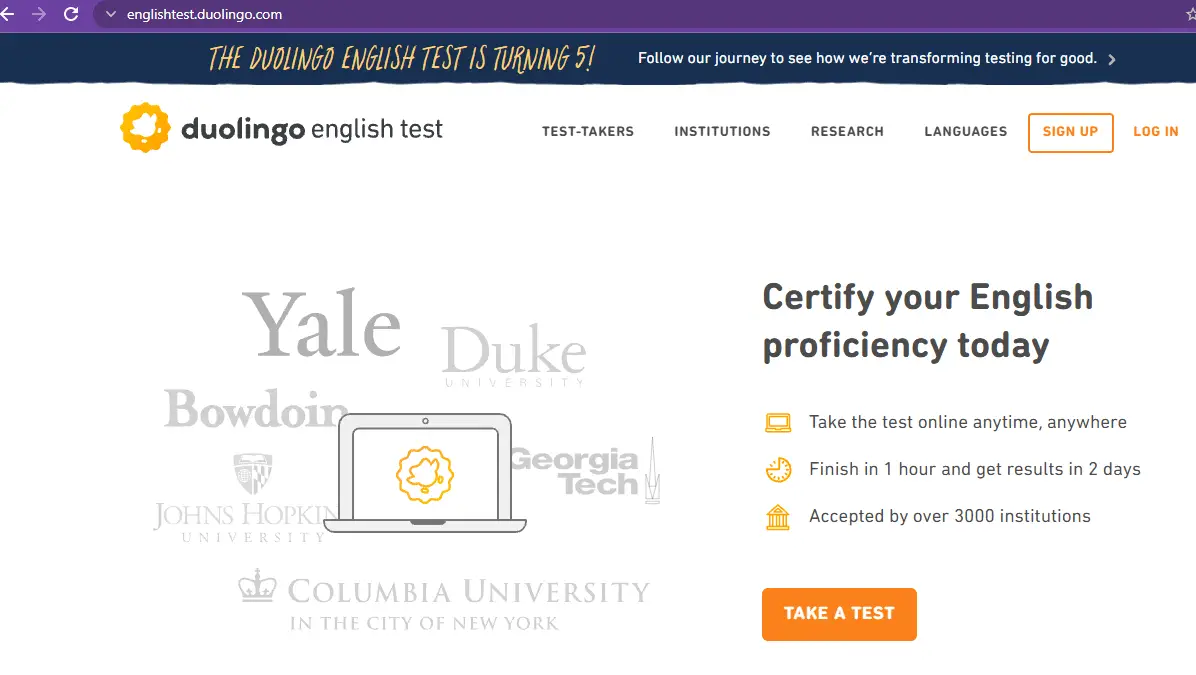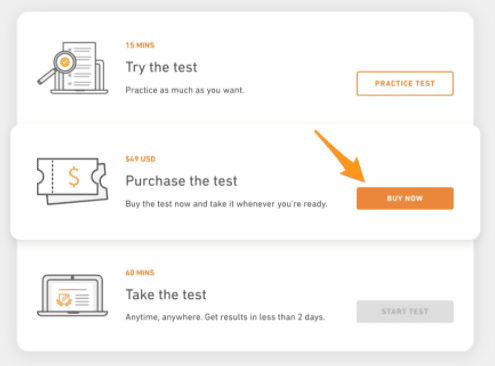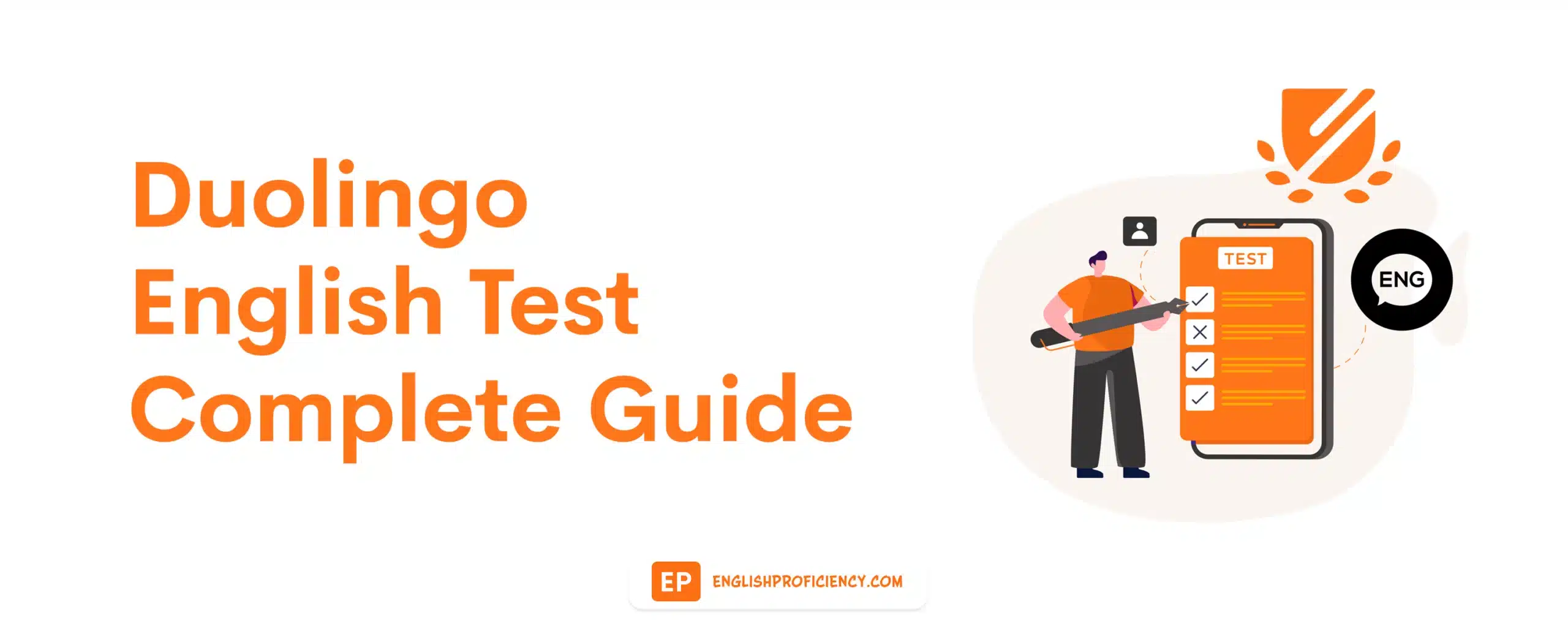One of the most commonly used proficiency language tests nowadays is the Duolingo English Test.
IELTS, TOEFL, and TOEIC are just some of the most regularly used English language tests. However, the Duolingo English Test has leveled up the game in this field. It is now a strong competitor for giving excellent, accurate, efficient, and reliable English proficiency test results.
Before you sign up for the Duolingo English test, let’s get into details for this popular English Language Test. This article will also find out why Duolingo is gaining more popularity among the traditional English Tests available such as the TOEFL, IELTS, CPE, ISE, etc. The DET is highly accepted by thousands of universities and colleges here and abroad.
This article will also give you a detailed outlook regarding the Test with some tips on preparing for it to help you ace the Duolingo English Test.
- What is the Duolingo English Test?
- Why Take the Duolingo English Test?
- How to Register for the Duolingo English Test
- How is Duolingo’s English Test Different from the TOEFL and IELTS?
- Where is the Duolingo English Test Accepted?
- Duolingo English Test Exam Format
- Duolingo English Test Scoring
- How to Prepare for the Duolingo English Test?
What is the Duolingo English Test?
The Duolingo English Proficiency Test or DET is a modern, comprehensive, and on-demand English proficiency examination tool to assess English language skills for both native and non-native English speakers. The language learning platform and app developer, called Duolingo, created this English language test.
It includes test areas in primary English skills in reading, writing, speaking, and listening. Also, you can take the Duolingo online examination on your computer at home. That is an advantage over other English Proficiency tests where you might need to go to test centers or admission offices to take the Test. Also, the Duolingo English Fluency Test can certify one’s English proficiency as well.
Why Take the Duolingo English Test?
Showcasing your English proficiency can help you with your college admissions or even in your career. In most cases, especially for non-native English speakers, taking an English proficiency test required for admissions is good.
In this way, you know your standing and your proficiency when it comes to the English language. Aside from being one of the formal requirements for universities, employers, immigration offices, and the like, taking the Duolingo English Fluency Test is much more convenient than TOEFL and IELTS, especially during this pandemic.
The Duolingo English Proficiency Test is an accessible and inexpensive English proficiency assessment; you will receive your test results within 48 hours. Also, it is accepted by thousands of colleges and universities worldwide.
How to Register for the Duolingo English Test
Accessing and registering for it:
1. Visit the official website of the Duolingo English Test

2. Create an account

3. Purchase the Test for USD 49.

4. Click the “Take the Test” button.

How is Duolingo’s English Test Different from the TOEFL and IELTS?
One of the significant differences between Duolingo English and TOEFL and IELTS is that it is adaptive, which means that the test difficulty level is based solely on your previous answers.
Moreover, IELTS contains traditional item types, like multiple-choice questions, essay questions, and more. In contrast, the Duolingo questions are dynamic and take on a new format, which is described as fun by the test takers.
It is also why the Duolingo English Test is a reasonably short examination that only lasts for 45 to 60 minutes in contrast to IELTS, which takes over two days.
Also, you can get your Duolingo English Test results in a span of 48 hours, while the TOEFL and IELTS can take approximately 6 to 10 days after taking the Test.
In addition to that, the Duolingo English Test offers an unlimited amount of shares of your results or scores to various colleges and universities with no additional payment. However, unlike TOEFL, they charge a different amount of $20 after the first four shares of your scores.
When it comes to the pricing of these English language proficiency tests, the Duolingo English Test is only USD 49, which is a lot cheaper than TOEFL and IELTS with the pricing of $160-250, depending on your country’s location.
Where is the Duolingo English Test Accepted?
Thousands of institutions, universities, colleges, and secondary schools worldwide recognize the Duolingo English Test as part of their admissions process.
Here is a list of some of the institutions and universities around the globe that accept the Duolingo English Test.
United States of America (USA)
Germany
- University of Applied Sciences Europe Germany
- Jacobs University Bremen
- Brand University of Applied Sciences
- Technische Universitat Berlin
- Victoria International University of Applied Sciences
- Accadis Hochschule Bad Homburg
- Schiller International University, Heidelberg Campus
- CBS International Business School
- Bard College Berlin
- Berlin International University of Applied Sciences
- IU Internationale Hochschule
- University of Applied Sciences Europe
Other European Countries
- Athlone Institute of Technology (Ireland)
- CCT College Dublin (Ireland)
- Cork Institute of Technology (Ireland)
- DIFC – Dublin International Foundation College (Ireland)
- Dorset College (Ireland)
- Dublin Business School (Ireland)
- Dublin City University (Ireland)
- Dundalk Institute of Technology (Ireland)
- Galway Mayo Institute of Technology (Ireland)
- IBAT College Dublin (Ireland)
- Institute of Technology Carlow (Ireland)
- Institute of Technology Sligo (Ireland)
- Maynooth University (Ireland)
- University of Limerick (Ireland)
- Waterford Institute of Technology (Ireland)
- International Business School – Budapest (Hungary)
- University of Pecs – Undergraduate (Hungary)
- Central European University – Undergraduate (Hungary)
- Universita Cattolica del Sacro Cuore (Italy)
- The American University of Rome (Italy)
- Audencia Business School (France)
- Burgundy Business School (France)
- ESC Clermont Business School (France)
- The American Business School of Paris (France)
- Schiller International University – Paris Campus (France)
- ICD International Business School (France)
- Dania Academy (Denmark)
- RTU Riga Business School (Latvia)
- LCC International University (Lithuania)
- Franklin University Switzerland (Switzerland)
- Webster University Geneva (Switzerland)
- Business School Lausanne (Switzerland)
- Ecole hoteliere de Lausanne – EHL (Switzerland)
Middle Eastern Countries
- Business Management Vocational School in North Cyprus (Cyprus)
- Quality Education Holding Company (Saudi Arabia)
- Ballsbridge Cyprus – Centre of the Ballsbridge University (Cyprus)
- Cyprus West University (Cyprus)
- European Leadership University – Famagusta (Cyprus)
- Tabanan Institute of Higher Education (Iran)
- Komar University of Science and Technology (Iraq)
- Tel Aviv University (Israel)
- IDC Herzliya (Israel)
- American University of Beruit (Lebanon)
- Lebanese American University (Lebanon)
- University of Balamand (Lebanon)
- Georgetown University Qatar (Qatar)
- Texas A&M University Qatar (Qatar)
- Nest Academy of Management Education Dubai (UAE)
- Rabdan Academy (UAE)
- Cyprus Science University (Turkey)
Asian Countries
- East Asia School of Theology (Singapore)
- The International College of Xiamen University (China)
- Southern University of Science and Technology (China)
- Northwestern Polytechnical University (China)
- Duke Kunshan University – Undergraduate (China)
- Macao Polytechnic Institute (China)
- University of Cyberjaya (Malaysia)
- Swinburne University of Technology Sarawak Campus (Malaysia)
- Curtin Singapore (Singapore)
- Shinshu University (Japan)
- Ritsumeikan Asia Pacific University (Japan)
- Tokyo Metropolitan University (Japan)
- Waseda University – School of Political Science and Economics (Japan)
- Nagoya University of Commerce & Business (Japan)
- University of Aizu (Japan)
- Doshisha University, The Institute for the Liberal Arts (Japan)
- Tokyo Christian University (Japan)
- Nagoya University – Undergraduate (Japan)
- Tokyo International University (Japan)
- Kansai Gaidai University (Japan)
- University of Tsukuba (Japan)
- Kyoto University of Advanced Science (Japan)
- International College of Liberal Arts (iCLA), Yamanashi Gakuin University (Japan)
- Yale-NUS College (Singapore)
- Nanyang Academy of Fine Arts (Singapore)
- The Hong Kong Polytechnic University (Hong Kong SAR China)
- City University of Hong Kong – Undergraduate (Hong Kong SAR China)
- Hang Seng University of Hong Kong (Hong Kong SAR China)
- Lingnan University (Hong Kong SAR China)
- Ghent University Global Campus (South Korea)
- Yonsei University – International Admissions (South Korea)
- Inha University (South Korea)
- Woosong University (South Korea)
- Handong Global University (South Korea)
- SolBridge International School of Business (South Korea)
- The State University of New York, SUNY Korea (South Korea)
- Universitas Pelita Harapan (Indonesia)
- Jakarta International College (Indonesia)
- Universitas Esa Unggul (Indonesia)
- Tribhuvan University (Nepal)
- Hitmaker Global Academy (Singapore)
- CMKL University (Thailand)
- Mahidol University International College (Thailand)
- Stamford International University (Thailand)
- Fulbright University Vietnam (Vietnam)
- The American University of Afghanistan – Kabul (Afghanistan)
- Notre Dame College Dhaka (Bangladesh)
- Karaganda State Industrial University (Kazakhstan)
- Adventist International Institute of Advanced Studies (Philippines)
- Asia Pacific Theological Seminary – APTS (Philippines)
Latin American and South American Countries
- Quality Leadership University (Panama)
- Universidad Especializada de las Americas (Panama)
- Universidad Tecnologica de Panama (Panama)
- Universidad InterNaciones (Guatemala)
- Universidad San Pablo de Guatemala (Guatemala)
- Escuela de Communicacion Monica Herrera (El Salvador)
- Escuela de Caracter y Ciudadania de Peru (Peru)
- Universidad Privada San Pedro (Peru)
- Federal University of ABC (Brazil)
- Insper Instituto de Ensino e Pesquisa (Brazil)
- Instituto Federal Sul de Minas Gerais (Brazil)
- Universidade do Vale do Itajai (Brazil)
- Universidade Federal da Fronteira Sul (Brazil)
- Universidade Luterana do Brasil (Brazil)
- Universidad Central de Chile (Chile)
- Universidad Arturo Prat – UNAP (Chile)
- Universidad del Desarrollo (Chile)
- Universidad Finis Terrae – Santiago (Chile)
- Univerisdad Mayor de Chile – antiago (Chile)
- Fundacion Universitaria Autonoma de las Americas – Medellin UAM (Colombia)
- Universidad de La Sabana (Colombia)
- Universidad de los Llanos (Colombia)
- Universidad de Manizales (Colombia)
- Universidad del Magdalena (Colombia)
- Fundacion Universitaria Maria Cano (Colombia)
- Fundacion Universitaria Monserrate (Colombia)
- Universidad Sergio Arboleda (Colombia)
- Universidad Isaac Newton (Costa Rica)
- Universidad Libre de Derecho de Costa Rica (Costa Rica)
- Universidad Magister (Costa Rica)
- Universidad para la Cooperacion Internacional – UCI (Costa Rica)
- Universidad Veritas (Costa Rica)
- Universidad Anahuac Mayab (Mexico)
- Universidad Anahuac Oaxaca (Mexico)
- Universidad del Golfo de Mexico Rectoria Centro (Mexico)
- Instituto Tecnologico de Soledad Atlantico (Mexico)
- Universidad de la Cienega (Mexico)
- Universidad del Claustro de Sor Juana (Mexico)
- Universidad Tecnologica de Cancun (Mexico)
- Universidad Tecnologica de la Riviera Maya (Mexico)
- Universidad Politecnica de Baja California (Mexico)
- Universidad Catolica Andres Bello – UCB (Venezuela)
Duolingo English Test Exam Format
The Duolingo English Test centers on reading, listening, speaking, and writing. Also, it does not have long reading and writing type of questions. Instead, it only uses short questions that still measure the same skills.
It is presented earlier that Duolingo is a computer-adaptive test (CAT) which means that the difficulty level of the examination varies depending on the takers’ performance. The higher the scores in the early parts, the difficulty of the exam increases as the test progresses.
On the other hand, if the test-taker has lower scores on the previous parts, the difficulty level of the following questions is on a lower scale. It differs from the conventional English tests that are available, and it is more dynamic.
Various test questions may include the following:
- Listening to spoken words and determining the correct one.
- Completing missing letters from a text or sentences.
- Write down what is happening in the given picture.
- Reviewing written terms and picking the right one.
- Describing an image in writing or through recitation.
- Recording yourself while saying a written sentence or paragraphs.
- Verbally answering spoken questions.
- Answering written questions through writing with 500 words, more or less.
- Typing out statements from an audio clip.
Moreover, the Duolingo English Test also includes a “video interview” part of the exam. In this section, you are to speak for one to three minutes on a particular topic given.
Three sections:
1. Quick Setup
One only needs to take the Test from one’s home anytime by using a computer and webcam. Therefore, appointments to test centers are no longer required. Instead, you will be given a quick ten to fifteen-minute try before purchasing the Test.
And when you are ready, you will be given instructions on how to download the app, and a quick preparation process to check if your camera and microphone are working correctly. Then, you are asked to submit your ID. Afterward, you will be introduced to the test rules and requirements.
During the exam, your computer is locked, hindering you from checking other tabs or documents that you might want to access. This feature ensures the validity of the results of your exam.
2. Adaptive Questions
It means that the Duolingo English Test uses adaptive technology wherein the difficulty of the questions adapts to each test taker. Mainly, if you answer a question correctly, the next question will be more challenging than the first one, and so on.
However, if you get a wrong answer, then the next question will be easier. The test difficulty will depend on how you are performing and how fluent you are with the English language.
It is also expected to stumble upon different question types that include speaking, writing, reading, and listening. This section will take about 25 minutes.
3. Video Interview & Writing Sample
After you complete the adaptive Test, you will get the chance to display your writing and speaking skills to the institutions that you are applying for. However, this section is not graded but will be available and included in your record, then forwarded to any institution of your choice.
You will also get to choose one of the two speaking prompts. Again, you will be given three minutes to complete this. You also get to choose one writing prompt out of two, and a five-minute duration is given for you to respond to this in writing.
7 Test Tasks
1. C-Test
The task has a short written passage with three to four sentences. In this Test, you need to complete the missing words or letters in the sentences.
2. Yes/No Vocabulary Task – Written
Here, you are given a list of English words and pseudo-words, wherein you need to identify the actual English words.
3. Yes/No Vocabulary Task – Audio
Here, you need to click on a sound icon, and an oral recording is played. This task requires you to identify if the audio is an actual English word or not.
4. Dictation
The dictation task is given with a sentence or two for you to type using the keyboard. You are given a minute to complete the task, and you can hear the prompt text up to three times before you start typing.
5. Elicited Imitation (Read-aloud)
In this certain task, a written sentence is presented, and then you will read the sentence aloud while using the computer’s microphone.
6. Extended Speaking
The extended speaking task requires you to respond orally to the following: a picture description, two different written prompts, and an aural or auditory prompt wherein you can hear it a maximum of three times. You are given a 30-second preparation for your response to each.
7. Extended Writing
For the extended writing section, you need to respond to four different prompts that include a three-picture description and a written prompt in which you are required to either describe it, recount it or make an argument. Your response to each will need a maximum of 50 words.
The Oral Interview and Writing Sample
Here, the examinee is needed to complete a non-graded oral interview and writing sample. The first task is about a topic or question that you have chosen to speak about for one to three minutes while video recorded by the Duolingo app. On the writing sample, you select a topic to write about for three to five minutes.
-
To get an in-depth understanding of the exam format, here’s our comprehensive guide on Duolingo English Test Exam Pattern
What is the Duration of the Duolingo English Test?
The entire Test takes 45 to 60 minutes approximately.
Then, it takes 48 hours for the test results to be certified and shared with multiple institutions and universities worldwide.
What are the Rules of the Duolingo English Test?
- You must be alone in a private, quiet, and well-lit room.
- Ears must be visible and are not covered.
- Your face must be clear, visible, and uncovered.
- Headphones and earphones are not allowed.
- Outside materials such as mobile devices, notes, books, and other gadgets are not allowed.
- You are not allowed to converse with anyone else.
- No writing materials and paper.
- You are not allowed to look away from the screen.
- Do not leave the test window for any reason.
- You are not allowed to use any predictive input method.
- The use of third-party web camera software is prohibited.
- Using a second monitor or any software that allows screen sharing or remote access is not permitted.
- Speak for at least 30 seconds on the topics presented during the graded speaking section.
- Do not use another person’s name or ID information to take the Test.
What are Duolingo English Test Requirements?
You must have the following:
- A valid passport, driver’s license, or any government-issued ID.
- A private and well-lit room.
- Sixty minutes of uninterrupted time.
- Reliable and fast internet connection.
- A computer with a front-facing camera, microphone, and speakers.
Duolingo English Test Scoring
The Duolingo English Test measures one’s English ability using a scale that ranges from 10-160 and is scored with 5 points increments. Below is a breakdown of the categories per scale.
The certified test results of Duolingo and all scoring are computer-based.
Their scale of 10 to 160 can be converted using the CEFR (Common European Framework of Reference for Languages) for further evaluation.
- English Basic User (A1, A2)
- A1 (Beginner)
- A2 (Elementary English)
- English Independent User (B1, B2)
- B1 (Intermediate English)
- B2 (Upper-Intermediate English)
- Proficient English User (C1, C2)
- C1 (Advanced English)
- C2 (Proficiency English)
Universities in the USA require a minimum score of 105 to 110. In contrast, most institutions in Canada require a minimum score of 115 and some programs and universities require higher scores depending on the courses you want to take.
-
For a detailed understanding of how scoring works, check out our comprehensive guide on Duolingo English Test Scoring.
How to Prepare for the Duolingo English Test?
After learning all the essential information about the Duolingo English Test mentioned above, the only question left here is, “Are you now ready to take the test?” Unfortunately, knowing only the background of the Test is not enough preparation for you to get high scores for the Duolingo English Test.
This section will help you prepare for the Duolingo English Test and ace your way to the top. The easiest and best way to prepare for the Test is by utilizing the various practice tests you could find online and offer on the Duolingo website. You can access this after signing up on their official website.
You could never go wrong with the notion that practice makes perfect, always. Unfortunately, the available practice tests usually only last around 15 minutes, while the real Duolingo English Test lasts about 40 to 60 minutes.
However, you need to keep taking these practice tests to hone your skills and help yourself get familiarized with the type of questions. It will also help you understand the structure of the Test and help you get comfortable answering them.
Keep in mind that you can take these practice tests as many times as possible. However, unlike IELTS, TOEFL, and the likes, there is no standardized technique preparation for the Duolingo English Test. Therefore, it is crucial to go through the practice tests first before taking the real one.
Below are some of the English skills that you need to practice and improve.
Speaking
Build a strong foundation in terms of your speaking skills. It will help you be eloquent in English. Expand your vocabulary. Try to learn new words every day. A few good resources for enriching your vocabulary are watching TV shows, movies, documentaries, and more.
Pay attention to the words they say, how they pronounce them, and the diction and expressions while telling them. Then, do some research, keep notes, and on how they pronounce certain words or phrases.
You may also check out different online dictionaries, and videos about English pronunciation tutorials, or listen to podcasts that discuss such topics. It is also good to start practicing tongue twisters.
Lastly, and most importantly, is to build your confidence in speaking English. You may start by practicing speaking daily in front of the mirror. Talk to yourself, converse about how your day went, or you may retell the story that you have read and so on.
The key here is to improve your speaking skills and confidence. Commit to practicing often and level up by talking to various people every day, this may be one of your friends or even a family member.
Reading
Having strong reading skills can help you interpret easily and decode the meaning of anything you read. It also enhances your comprehension, fluency, and enriched vocabulary, which will lead to effective communication and learning.
To improve your reading skills, the first thing you need to do is read more and more. If you are not into reading, build a habit. Put up a daily reminder for yourself, like by nine o’clock, I’m going to read two chapters of your book choice. Do this every night, religiously.
Set reading goals that will help you widen your vocabulary and your comprehension. Use different reading materials such as newspapers, magazines, ebooks, online articles, science journals, books, and the like.
Take notes of the essential details regarding the topic you have read about. Learn to summarize everything. Then, pull out only the key concepts and main ideas. You also need to learn speed reading. It is another helpful strategy to improve your reading comprehension by identifying only the keywords in each paragraph.
Most importantly, practice every day and stay focused on what you are reading. Also, know what time you are most likely to be comfortable reading and start from there. Finally, be sure to cover many topics and different reading materials to help you advance your reading skills.
Writing
Your written English skills are also crucial and a real challenge to improve. The first thing to consider is your vocabulary. To express yourself clearly, you need an excellent active set of words. Knowing a lot of words is not enough to have good writing ability.
It also means that you need to be able to use these words correctly. That is why it is essential to learn new words and use them in sentences and phrases. A good trick for this is knowing all the specific word forms and the commonly used prepositions.
Another thing to consider is for you to learn how to spell these words precisely. Keep in mind that incorrect spelling changes the meaning of your sentences, thus creating confusion for the reader.
Grammar is also essential in improving your writing skills. Make sure to use the appropriate tense and remember to use punctuation. And do not forget to proofread your writing a couple of times. Finally, remember that grammar mistakes and misspelled words can spoil your writing, and we don’t want that.
Listening
To improve your listening skills, you need to listen genuinely. Listen with focus and attentiveness. Avoid passive listening; instead, practice active listening. For example, pay attention to someone who is speaking. With this, you will hear the message distinctly.
Another thing you should keep in mind is to get used to the differences in how words sound on their own and how they sound when used in context. In addition to that, audiobooks, radio shows, movies without subtitles, and podcasts are great tools that you can use to enhance your listening skills.
What if you did not understand it the first time? Try again. Listening to audio a couple of times can help you catch up with phrases and keywords you have missed before. It will help you with comprehension and fluency. Also, remember to cover topics that are relevant to you; this is good for beginners.
Moreover, do not stick to audio materials you are too comfortable with, meaning you can easily understand. Challenge yourself. If you want to improve your listening skills, go with challenging materials, such as an audio clip wherein the speakers are fast talkers and challenging to understand.
It is also good to explore various English accents and topics that you are not familiar with. Improving your listening skills might take more effort and a lot of focus from your end, but if you are consistent and motivated, you can surely make significant improvements.
Additional Reading — Duolingo English Test Test Guide


